
Spiny lizards is a common name for the genus Sceloporus in the family Phrynosomatidae. The genus is endemic to North America, with various species ranging from New York, to Washington, and one occurring as far south as northern Panama. The greatest diversity is found in Mexico. This genus includes some of the most commonly seen lizards in the United States. Other common names for lizards in this genus include fence lizards, scaly lizards, bunchgrass lizards, and swifts.

Coral snakes are a large group of elapid snakes that can be divided into two distinct groups, the Old World coral snakes and New World coral snakes. There are 16 species of Old World coral snakes, in three genera, and over 65 recognized species of New World coral snakes, in two genera. Genetic studies have found that the most basal lineages have origins in Asia, suggesting that the group originated in the Old World. While new world species of both genera are venomous, their bites are seldom lethal; only two confirmed fatalities have been documented in the past 100 years from the genus Micrurus. Meanwhile, snakes of the genus Micruroides have never caused a medically significant bite.

Boiga is a large genus of rear-fanged, mildly venomous snakes, known commonly as cat-eyed snakes or simply cat snakes, in the family Colubridae. Species of the genus Boiga are native to southeast Asia, India, and Australia, but due to their extremely hardy nature and adaptability, have spread to many other suitable habitats around the world. There are 38 recognized species in the genus. According to the study done by Jiří Smíd regarding Old World cat snakes, the ancestor of the cat snake originated in Africa, from where it diversified and expanded to other countries. Despite this diversity however, the different species have very similar needs in terms of temperature and precipitation.
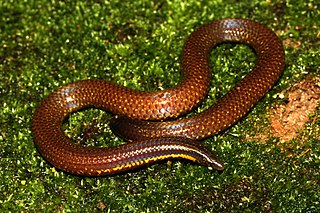
Uropeltis ellioti, commonly known as Elliot's earth snake and Elliot's shieldtail, is a species of snake in the family Uropeltidae. The species is endemic to India.

Tantilla is a large genus of harmless New World snakes in the family Colubridae. The genus includes 66 species, which are commonly known as centipede snakes, blackhead snakes, and flathead snakes.
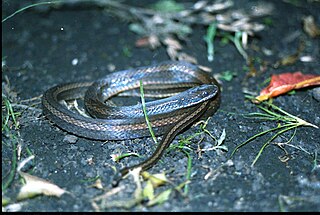
Coniophanes is a genus of colubrid snakes, commonly referred to as black-striped snakes, but they also have many other common names. The genus consists of 17 species, and despite the common name, not all of them display striping.

Ficimia is a genus of colubrid snakes commonly known as hooknose snakes or hook-nosed snakes, which are endemic to North America. There are seven species within the genus.

Pseudonaja is a genus of highly venomous elapid snakes native to Australia. Species of this genus are known commonly as brown snakes and are considered to be some of the most dangerous snakes in the world; even young snakes are capable of delivering a fatal envenomation to a human.

Calliophis is a genus of venomous elapid snakes, one of several known commonly as oriental coral snakes or Asian coral snakes.
Hobart Muir Smith, born Frederick William Stouffer, was an American herpetologist. He is credited with describing more than 100 new species of American reptiles and amphibians. In addition, he has been honored by having at least six species named after him, including the southwestern blackhead snake, Smith's earth snake, Smith's arboreal alligator lizard, Hobart's anadia, Hobart Smith's anole, and Smith's rose-bellied lizard. At 100 years of age, Smith continued to be an active and productive herpetologist. Although he published on a wide range of herpetological subjects, his main focus throughout his career was on the amphibians and reptiles of Mexico, including taxonomy, bibliographies, and history. Having published more than 1,600 manuscripts, he surpassed all contemporaries and remains the most published herpetologist of all time.
Pseudohaje is a genus of venomous African elapid snakes, commonly called tree cobras or forest cobras because of their arboreal lifestyle. Their ability to produce a hood is limited to a slight flattening of the neck.

Geophis is a genus of snakes in the subfamily Dipsadinae of the family Colubridae of the superfamily Colubroidea. Species in the genus Geophis are commonly referred to as Latin American earth snakes. The genus consists of 53 distinct species.
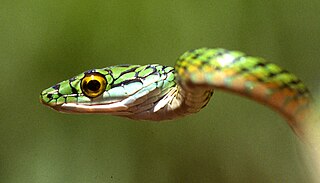
Leptophis is a genus of colubrid snakes, commonly known as parrot snakes. The species within this genus are widely distributed throughout Mexico, Central and South America.

Atractus is a genus of colubrid ground snakes in the subfamily Dipsadinae. The genus includes more than 140 distinct species.
Calliophis maculiceps, commonly known as the speckled coral snake or the small-spotted coral snake, is a species of venomous elapid snake endemic to Southeast Asia. Five subspecies are recognized, including the nominotypical subspecies.

Tropidodipsas is a genus of New World snakes of the family Colubridae.
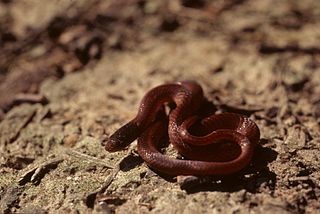
Rhadinaea is a genus of snakes of the family Colubridae.
Conopsis acuta, the spotted Tolucan earth snake, is a species of nonvenomous snake in the family Colubridae. The species is found in Mexico.
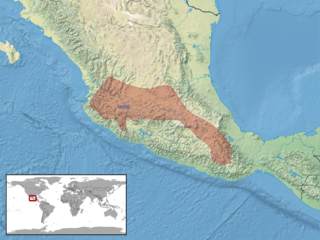
Conopsis biserialis, the two-lined Mexican earth snake, is a species of nonvenomous snake in the family Colubridae. The species is found in Mexico.
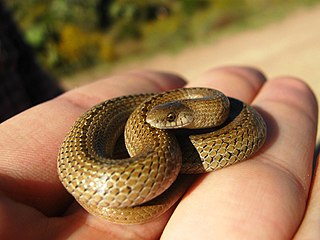
Conopsis lineata, the lined Tolucan ground snake or lined Tolucan earth snake, is a species of nonvenomous snake in the family Colubridae. The species is found in Mexico.















